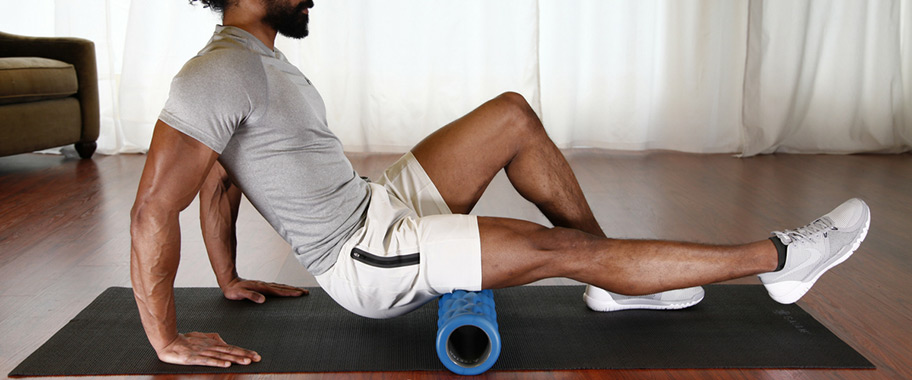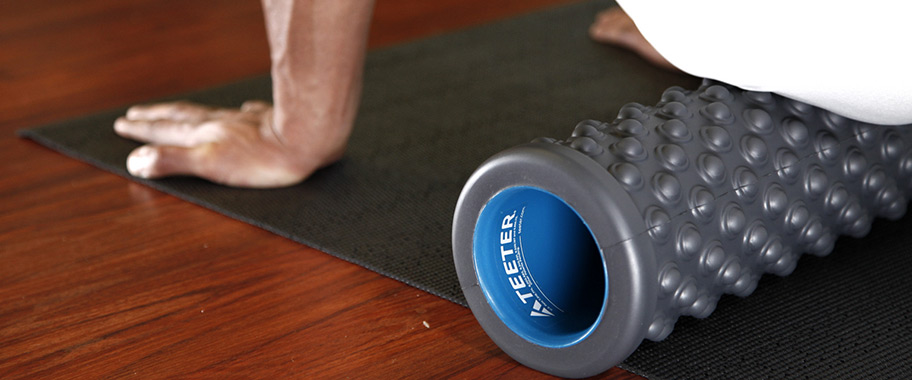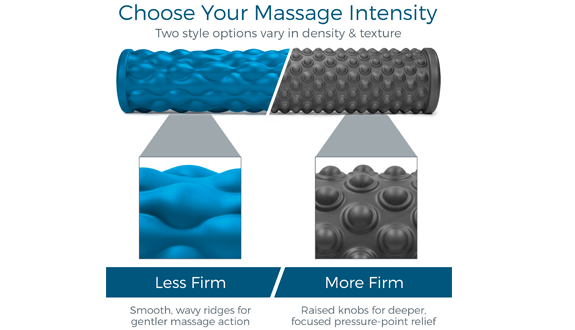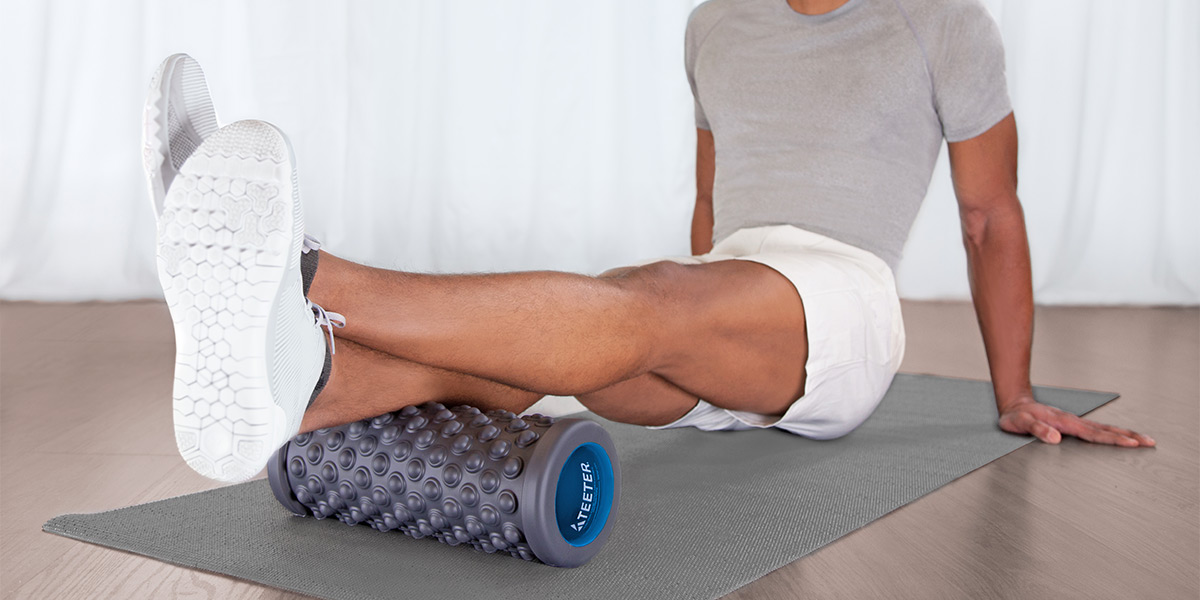A foam roller is a performance and recovery tool that offers an effective and affordable way to achieve a deep tissue massage. Foam rolling releases painful knots and stimulates blood flow to enhance performance and speed up the healing process.
In a nutshell, foam rolling can help with:
- Chronic back pain
- Stiffness from sitting for extended periods of time
- Myofascial Release
- Flexibility and Range of Motion
- Posture
- Injury-Prevention
- Recovery from Workouts
- Better Sleep
This article will take a deeper dive into the benefits of foam rolling and offer advice on choosing the best foam roller for you and your body. But first, we’ll briefly explain how foam rolling works.
How Foam Rollers Work
Foam rollers allow you to self-massage painful knots and tense muscles – also known as “trigger points” – by placing the foam roller underneath you and slowly rolling over the tender or stiff areas. This process of relieving painful trigger points is commonly referred to as “Myofascial Release.”
As explained in the Recovery Journey, “Myo” means muscle and “fascia” is the connective network of tissue surrounding and supporting your muscles and organs, holding them in place like a web.
If one part of that web is damaged, a blockage is created – dehydrating the fascia and forming painful adhesions (or ‘knots’) – which restricts movement and presents itself as pain to the injured site while often radiating pain across other areas of the body as well.
Dehydrated fascia not only inhibits your ability to recover and heal properly but also makes you more prone to injury or chronic pain.
The best analogy to illustrate the importance of well-hydrated fascia comes from Breaking Muscle who compares fascia to a sponge:
“When a sponge dries out it becomes brittle and hard. It can easily be broken with only a little force because of how crispy it has become. However, when a sponge is wet and well-hydrated it gets springy and resilient. You can crush it into a little ball and it bounces back. You can wring it and twist it, but it is difficult to break.”
Using a foam roller for myofascial release smooths out the knots and re-introduces fluid to the tense muscles and fascia, like adding water to a sponge, allowing you to recover faster and move better.

Benefits of Using a Foam Roller
Reduce Chronic Back Pain
Foam rolling most likely isn’t a permanent solution to chronic back pain, but it can certainly help release the painful knots, reduce inflammation, and relieve some of your discomfort and pain. Easing the pain may give you the energy and strength you need to become more active and target the real source of your pain. For chronic back pain sufferers, pairing foam rolling with daily inversion therapy will make a significant difference in your journey to recovery and long-lasting relief.
Relieve Muscle Stiffness
If you spend extended periods of time sitting – whether it’s at a desk, in a car, or on an airplane – you’re probably no stranger to the stiffness and aches that accompany it. Sitting is an unnatural position that forces the muscles and joints to compress and tighten. The longer we hold that compressed position, the more tense and inflexible the myofascial tissue and muscles become. Foam rolling helps decompress and relax those stiff muscles back to their natural position and release the tense trigger points that built up in the fascia.
Pre-Workout Rolling for Injury-Prevention
Foam rolling increases circulation and helps prepare the body for movement by stretching and loosening the muscles prior to working out. This warm-up increases range of motion and reduces the risk of tears and strains so you can move and perform better. It also activates more muscles that otherwise wouldn’t have been ready to optimally function, resulting in a more effective workout.
Post-Workout Rolling for Recovery
Exercise puts a lot of stress on various muscles, tissue, and joints that were most likely inactive for the majority of the day. Foam rolling targets the over-worked muscle areas and prevents knots from building up afterward – which studies show reduces soreness and allows your muscles to recover quicker and more effectively. The quicker that your muscles are able to recover from the stress of working out, the more your body can focus its energy on burning excess fat.
Improve Posture
Bad posture not only affects your physical appearance, but it’s the cause of a lot of pain and suffering. The negative effects of poor posture can stem from a variety of possible causes. For some, it’s a more complex issue stemming from spinal disease, but for others, it’s simply from a bad habit of slouching and lack of core strength to hold the body upright – which can be addressed with regular foam rolling. Rolling can help flatten out rounded shoulders, realign your spine, even out muscle imbalances, and strengthen your core muscles which will help you stand taller and prevent unnecessary pressure on your spine.
Improve Flexibility and Range of Motion
Myofascial release restores your muscles to their optimal length and improves the elasticity of the surrounding tissue by removing any “knots” preventing fluid from getting in. Think back to the sponge example above, when the fascia is well-hydrated it can bend, twist, and move easily and freely without breaking. Muscles become trained to behave in a certain way through repetitive action; the more those muscles get stretched and moved, the more flexible they will become. If the muscles aren’t regularly stretched and moved, then they are essentially being trained to be tense and brittle by default.
Better Sleep
When you experience mental stress, your body reacts. It’s not uncommon for people who are stressed about work, finances, relationships, or other personal matters, to carry that stress in their neck and shoulders and feel the physical pain that accompanies it. Foam rolling before bed releases and relaxes the muscles where you’re carrying that extra tension, allowing for a more comfortable and restful night of sleep.
What is the Best Type of Foam Roller?
Foam rollers have come a long way in recent years, offering a variety of options for various results. Let’s take a look at the different features to consider.

Surface Texture
Foam rollers with textured surfaces and raised ridges allow for more precise muscle targeting as you roll out the knots and trigger points.
Intensity
The intensity of foam rollers (less firm vs more firm) allows for gentler or deeper massages to achieve different results.
Size
26″ – The extra length provides more stability while targeting larger muscle groups, allowing you to relax while you roll.
13″ – This shorter roller allows for more precise targeting of smaller muscle groups and is lightweight and portable to foam roll on the go.
How to Decide
Ultimately it comes down to personal preference and the purpose you want the foam roller to serve. Teeter recently designed two new Massage Foam Rollers to suit your preferred combination of intensity and size.
For first-time rollers or those looking for a more gentle and relaxing experience – we recommend choosing the blue wavy-textured (less firm) massage roller in your preferred size (13″ for portability or 26″ for stability).
For advanced rollers or those looking for a deeper tissue massage to release trigger points and boost recovery – choose the gray bumpy-textured (more firm) massage roller in your preferred size (13″ for small muscle targeting or 26″ for large muscle targeting).

STEP IT UP: Every Teeter Massage Foam Roller comes with an illustrated exercise guide for targeting specific trigger points to aid in recovery and improve range of motion of the back, hips, and legs.
Be Your Own Massage Therapist
The Teeter Massage Foam Roller massages sore muscles and releases tension and trigger-points better than anything you've experienced! Click to choose your foam roller and feel the relief.
